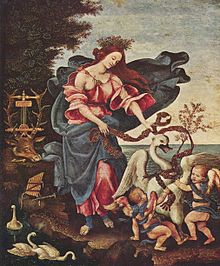Allegory (from Greek: ἄλλος, allos, "other", and ἀγορεύειν, agoreuein, "to speak") is a figurative mode of representation conveying a meaning other than the literal. Allegory teaches a lesson through symbolism. Allegory communicates its message by means of symbolic figures, actions or symbolic representation. Allegory is generally treated as a figure of rhetoric, but an allegory does not have to be expressed in language: it may be addressed to the eye, and is often found in realistic painting, sculpture or some other form of mimetic, or representative art. Simply put, an allegory is a device that can be presented in literary form, such as a poem or novel, or in visual form, such as in painting or sculpture. As a literary device,
An allegory in its most general sense is an extended metaphor. As an artistic device, an allegory is a visual symbolic representation. An example of a simple visual allegory is the image of the grim reaper. Viewers understand that the image of the grim reaper is a symbolic representation of death. Nevertheless, images and fictions with several possible interpretations are not allegories in the true sense. Furthermore, not every fiction with general application is an allegory.
Anti-novel --
An antinovel is any experimental work of fiction that avoids the familiar conventions of the novel. The term was coined by the French philosopher and critic Jean-Paul Sartre.
The antinovel usually fragments and distorts the experience of its characters, forcing the reader to construct the reality of the story from a disordered narrative.


No comments:
Post a Comment